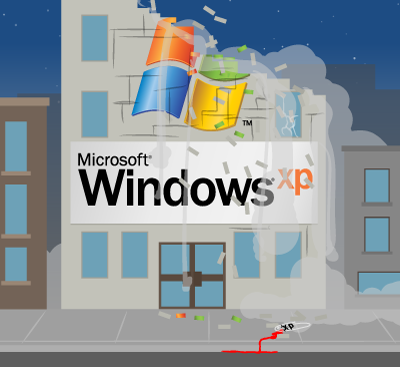-
-
products
-
resources
-
support
-
company
-
Are you still using Windows XP? – Prepare Yourself
By Steve Horton October 27, 20117, windows, Windows 7, Windows XP, xpNo CommentsIllustration: Gordon McAlpin If you are reading this article, chances are you are still using Windows XP on your computer.
Microsoft is ending support for Windows XP on April, 2014. Seems like a long way off, doesn’t it? That’s the date that Microsoft will officially end support for Windows XP. If there are any security issues, driver revisions, or bug fixes that need to be made to XP after that point, too bad — Microsoft will have moved on by then. This will render XP unsafe and, eventually, unusable for the majority of PC users.
The big problem with this is, we at ReviverSoft recognize that people want to go on using their old PCs, without having to upgrade. And most older PCs can handle Windows XP, but decidedly cannot handle Windows Vista or Windows 7.
What to do?
There are a few options you have in order to continue on past April 2014 with the PC you’ll have then.
1. Rely on Driver Reviver and Malware Protection
Although Windows Update will no longer function adequately on XP after April 2014, you can be assured that Driver Reviver will take its place, more than adequately. There’s a good chance that most of the best anti-malware apps, like Malwarebytes Anti-Malware, will continue to protect Windows XP indefinitely, though Windows Security Essentials likely won’t. With a good firewall in place, Driver Reviver, and Malwarebytes, you should be protected against any rogue security threats that Microsoft will no longer patch.
2. Change your OS
Your PC likely won’t support Windows Vista or Windows 7. All is not lost. Look into one of the easier Linux installations, such as Ubuntu, which is very much like Windows and is designed to be light and work on almost any PC. It’s also very easy to install and only takes a little bit of a learning curve compared to what you’re used to.
3. Inexpensive Upgrade + Windows 7
It’s possible that your PC may indeed be able to run Windows 7 with a little work on the hardware end. Try a cheap dedicated video card. Max out the RAM. See about taking the CPU out and replacing it with the best one that the motherboard will support. If none of that makes any sense, don’t worry about this step, but it’s likely that such upgrades will cost next to nothing at a good electronics store, and can be completed in an afternoon. Then, you’ll be able to move on to Windows 7 (or Windows 8, for that matter, as it’ll be out well before 2014).
4. A new PC
We consider this a last resort, but if you must buy a new PC before April 2014, there’s a good chance it’ll come with Windows 7 or Windows 8 already on it, and those two OSes will be supported for years and years. When all else fails, future proof by changing everything. The good news is, you won’t have to spend much to get a machine that can run Win7 or Win8 just fine; and you’ll be able to repurpose your old machine to do something else.
Whatever method you choose, you’ll be way ahead of Microsoft when they decide to pull the plug on Windows XP. There are still millions of you worldwide who use Windows XP, and it helps to be prepared.
Was this post helpful?YesNoFree Driver Updates
Update your drivers in less than 2 minutes to enjoy better PC performance - Free.
Free Driver Updates
Update your drivers in less than 2 minutes to enjoy better
PC performance - Free.
Didn't find your answer?Ask a question to our community of experts from around the world and receive an answer in no time at all.most relevant recent articles Pin It on Pinterest

